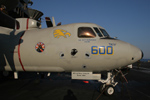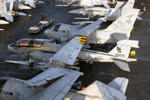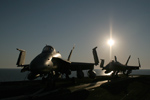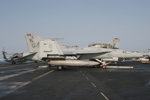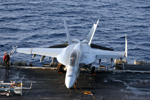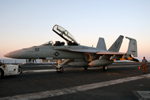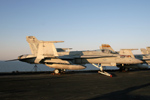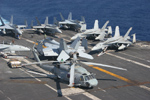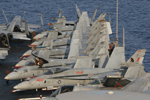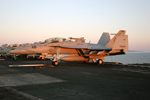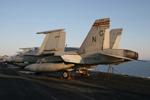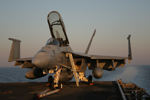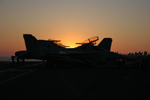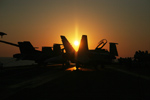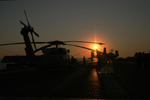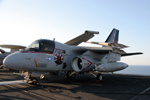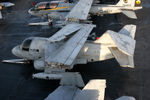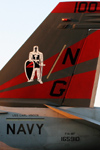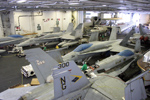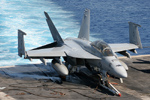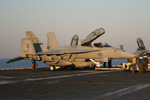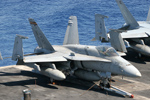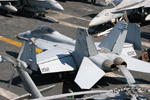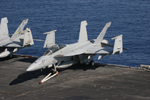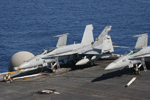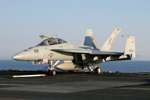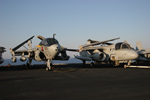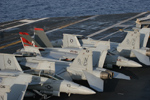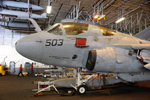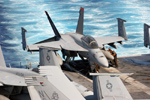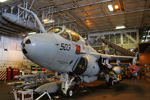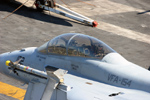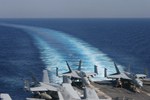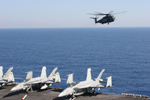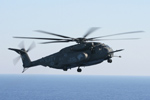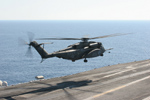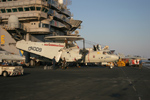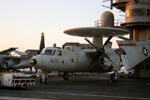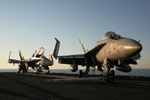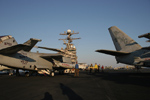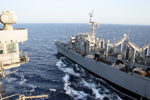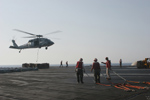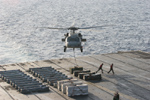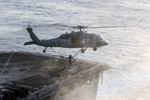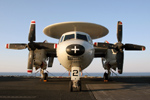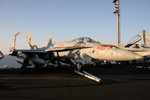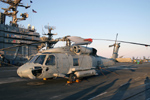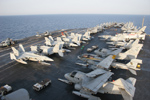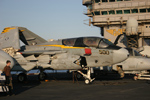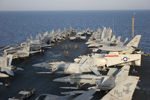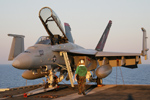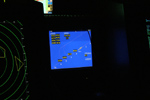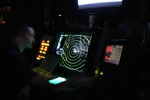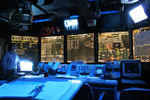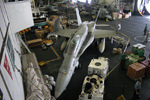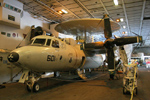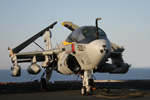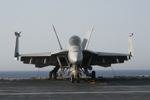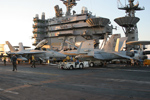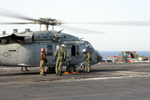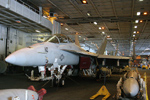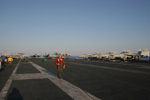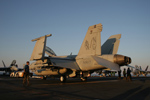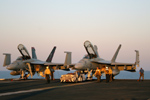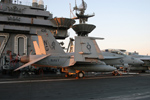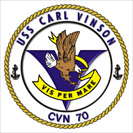  |
|||||
| Author:
Robin Powney Photography: Paul Tiller |
|||||
A
previous version of this article was first published on Air-Scene. |
|||||
|
Leaving NS Kitsap, Bremerton, for the last time early in the morning of 13 January 2005, the USS Carl Vinson (CVN-70) and, embarking on 18 January, Carrier Air Wing Nine (CVW-9), set sail for a 12-day Joint Task Force Exercise (JTFEX 05-02 and linked to the USAF's Blue Flag 05-01) and a rare six-month world cruise whereby she would leave Washington, conduct operations in support of the ongoing war against terror and then head towards Naval Station Norfolk in Virginia. Norfolk is her new home and just "next door" to where she will undergo a scheduled thirty-six-month long Refuel and Complex Overhaul (RCOH). During her twenty-three years, the Vinson has seen many combat theatres and was the first carrier to operate in the Bering Sea and last ever carrier to conduct A-6E Intruder launch and recovery operations. She was also the first ever USN ship to be named after a living civilian, Congressman Carl Vinson, in honour of the massive impact he had on American defence, especially the US Navy. |
||||
|
Arriving
at NAS Sigonella on Saturday, the base PAO welcomed us and we were taken
to Helicopter Combat Support Squadron Four's (HC-4) hangar and a quick
safety brief about what we had to wear and what we had to do should
the huge MH-53E end up taking a swim. Our taxi, MH-53E '40', left the
ramp at Sigonella (which it was sharing with Navy C-9s, P-3Cs, Ramstein
AB C-130s, one Dover AFB C-5, two C-2 Greyhounds, two EA-6B Prowlers
that had recently operated from Al Asad AB, Iraq, and a single Nimrod
MR.2) and roughly an hour later, after a relatively comfortable though
VERY hot flight, we were on the deck of America's Favourite Carrier,
the 'Gold Eagle'. We were then escorted down to the press centre, our
'home' for the next twenty-four hours and where we met Lt Cdr McIlnay,
his assistants and the USN journalists assigned to help us out. It is
here we found out we sadly wouldn't get to see any fixed wing flight
ops due to a much needed underway replenishment. |
Whilst aboard the USS Harry S. Truman back in April, I was acutely aware
of just how warm the ship was (and that was in UK 'sunshine') and wondered
to myself just how do people live and work in temperatures like these
- well, it now transpires the Truman must have had the air-conditioning
units switched off as the Vinson was perfectly comfortable in areas
that mattered (the aircon didn't cover the entirety of the ship). In
fact, in certain places, it was almost too cool - but with a deck sat
baking in the Med's glorious sunshine, anything cool was well received.
Some corridors were beyond bearable for anything more than a few minutes
as they weren't air-conditioned and on the subject of corridors, how
anyone can move round a CVN without getting completely and utterly lost
is somewhat of a puzzlement. Every corridor looks the same, stairwells
look the same - it all looks the same! |
|
|
A short while later, The Shogun Strike Team (aka CVW-9) became
the target for our cameras - the fantastic early evening sunlight couldn't
have been any better. After a walk round the hangar deck, we went up
'topside' for well over an hour, and were getting first-hand experience
of deck life as personnel were moving aircraft about right, left and
centre in readiness for the UNREP in the morning. One 'blue shirt' was
even heard to exclaim, to us, "God, what an excellent job!"…
who are we to argue, apart from being very jealous and I did wonder
where the application forms for deck crew were! Beautiful sunset, great
camaraderie and the fact that you're trusted with anything up to $80m
worth of frontline US Navy airpower. The Shogun Strike Team is currently
made up of VFA-154 Black Knights (F/A-18F Super Hornet), VMFA-323 Death
Rattlers (F/A-18C Hornet), VFA-146 Blue Diamonds (F/A-18C Hornet), VFA-147
Argonauts (F/A-18C Hornet), VAQ-138 Yellowjackets (EA-6B Prowler), VAW-112
Golden Hawks (E-2C Hawkeye), HS-8 Eightballers (SH-60F/HH-60H Seahawk)
and VS-33 Screwbirds (S-3B Viking). During their time in the Gulf, CVW-9
conducted 6,500 sorties - totalling more 20,000 flight hours and in
just over 4 months, from late March to late June, VFA-146, VFA-147,
VFA-154 and VMFA-323 racked up 7,500 flight hours with missions often
lasting more than thirteen hours. |
Alongside
CVN-70 in CSG-3 was DESRON31 (Destroyer Squadron 31), which is headquartered
at Pearl Harbor, and consists the guided missile cruiser CG-54 USS Antietam,
the two guided missile destroyers DDG-77 USS O'Kane and DDG-89 USS Mustin,
the fast-combat support ship AOE-2 USS Camden and the attack submarine
SSN-717 USS Olympia from Pearl Harbor's Submarine Squadron Three. As
CVN-70 has undergone a homeport shift from Bremerton, WA to Norfolk,
VA, CVW-9 units now have a longer trip home as they are from west coast
bases (Lemoore, Miramar, Whidbey Island, San Diego and North Island)
- they now have a massive 3,000 mile trek to look forward to following
the 'fly-off'. One HS-8 crewman told us that they would be looking at
four days of near continuous flying and a VFA-147 pilot mentioned that
due to the short legs of the Hornet, they'd be making three or four
fuel stops en-route home to Lemoore. |
|
|
It
has to be said that the CVN of the future will look a somewhat less
impressive place as most roles will be undertaken by a Hornet of some
description. Super Hornets have taken the role of the mighty F-14 in
providing Fleet Air Defence and precision strike (not to mention the
additional ace up its sleeve in that it is able to refuel other aircraft
thanks to the buddy refueling pod system and the much increased fuel
capacity); 'legacy' Hornets will continue in their current roles (until
USN Hornets get replaced by more Super Hornets - the USMC will retain
their Hornets until they get the F-35) and Prowlers will be replaced
by EA-18G Growlers. Thus, within ten to fifteen years, a typical Nimitz-class
carrier will be chock full of F/A-18E/F Super Hornets; even the helicopter
fleet is being 'standardized' onto the H-60/S-70, with the USN looking
at carriers being embarked with MH-60R Seahawks and MH-60S Knighthawks,
rather than the current SH-60F/HH-60H Seahawks. |
One
point that a Prowler WSO was keen to emphasise was that VAQ-138 were
the only true attack squadron on board - their only mission is attack,
be that electronically with the AN/ALQ-99 pods or 'physically' with
AGM-88 HARMs - either way, all they do is attack. The same WSO also
pointed out that, at low-level, thanks to the Intruder genes, there's
not a great deal can catch a Prowler. VAQ-138 has also recently been
awarded CVW-9s hotly-contested 'Golden Wrench' to recognise the superb
maintenance condition of their jets - the Yellowjackets had the highest
mission-capable rate in the deployment in support of Operation Iraqi
Freedom. Considering the Prowlers are not exactly young and are now
almost in their twilight years, that is one massive achievement by the
VAQ-138 maintainers! |
|
| Whilst
wandering on the deck, trying not to get in someone's way, we were introduced
to Col Yurovich, DCAG. This man is not far off a walking legend; his
logbook includes forty aircraft types including the A-4, F-4, AV-8 and
being part of the weapons test program for the F/A-18, not to mention
the fact that he currently flies F/A-18Cs. However, he is also in the
Marine Corps, thereby meaning he is the first ever USMC DCAG and will
soon become a CVWs first ever Marine CAG when he takes over command
of his own Carrier Air Wing. He also took time to explain to us why
the aircraft had all had a black USMC logo and 'Semper Fi' added to
them - VMFA-323 painted black bands on the tails of their Modex 200
'CAG bird' after the sad loss of two of their pilots over Iraq and the
rest of the airwing followed suit with the addition of the somber black
markings as a mark of respect to their missing colleagues. Unfortunately,
aircraft '200' was down in the hangar deck and, at the time (i.e. prior
to being told), we didn't know what the black bands represented and
it was in a difficult position to get a decent photo of. |
Later that evening, after raiding the squadrons for souvenirs, the choice was - "Do you want to go and take photos of the gym or go for a pizza?" Well, tough question! Let's just say the US Navy do know how to feed people. The pizza was fantastic and Saturday also turned out to be 'near beer' night, as USN ships are dry, the closest the personnel get to beer is the 0% ABV 'near beer', which, when ice cold, is actually very pleasant. Whilst we were tucking into our pizzas and 'beer', we were joined by a yellow-shirted 'shooter'. The jealousy for the job of the aforementioned blue shirt is nothing compared to the jealousy for the job of the shooter! This guy gets to launch the jets with their wings just feet above his head. Quite what the cranial (the funny looking helmet with built-in ear defenders) will do if you get hit on the back of the head by the wing of a thirty-tonne jet doing 200+km/h is beyond me… I would hazard a guess at not a great deal. |
The
next item on the itinerary was something, if I'm honest, I wasn't looking
forward to - sleeping. I had visions of uncomfortable cramped bunks
in a hot room. How wrong could I be! We were allocated bunks in a four-man
room (we were to share with two Boeing employees) and that was end of
my visions - the bunks are comfortable, the rooms are cool and were
not the ridiculous temperature I expected, although there is one slight
pitfall… an aircraft carrier is working 24/7. Thus you have to
get used to bizarre noises, doors (including the big lumps of steel
they call 'hangar doors') shutting, making bangs that sound like we've
gone to war again, and the odd feeling experienced when the ship turns
- you get used to them quick if you want any form of sleep. I don't
know how I managed it but I got a good night's sleep, until the six-am
wake-up anyway... |
Early
on Sunday morning, CVN-70 edged closer and closer to AOE-2 USS Camden
for the vital underway replenishment (headings and speed were defined
by the Camden, the Vinson matching them and sailing alongside, 160ft
abeam of the Camden's port side) - food, drinks, fuel, etc would be
brought from the Camden and munitions would be moved over to the Camden.
This particular UNREP was actually made up of CONREP and VERTREP - Camden's
MH-60S Knighthawk (from HSC-21 Blackjacks Det 6) was used to airlift
pallets (the VERTREP) from one ship to the other and cables/pulleys
were used to pull pallets from the Camden to the Vinson (the CONREP).
Witnessing an underway replenishment, with plenty that could go wrong,
is quite an eye-opening experience - and even more so considering the
USS Camden, when she gets home to Bremerton, will be decommissioned.
|
Whilst
it's fair to assume the Knighthawk crew(s) have done this sort of thing
before, every time they came back to pick up more munitions they were
swinging into exactly the right position each and every time (which
is a very good thing considering some of these boxes contained enough
explosive to make quite a mess), guided by a seemingly very competent
Landing Signals Enlisted, or LSE. After an hour or two in the early
morning sun watching this replenishment 'ritual' we went for the US
Navy Sunday special - brunch and smoothies. If anyone says food on an
aircraft carrier is substandard, don't believe them. I foolishly neglected
to try one of the fresh waffles but the rest of the food was absolutely
superb - considering that 16,000 meals are served daily, the cooks get
plenty of practice! |
A
short while after brunch we were briefed on on-deck safety procedures
including the safety equipment we were to wear - the 'floatcoat' and
what bits of it did, as we were to go topside to watch the VERTREP from
more of a 'worms-eye' view. Whilst down on the deck, one cannot fail
to be impressed by the organisation of the whole replenishment procedure
and pallets/boxes/etc are taken to wherever they need to be to be picked
up within seconds of the Knighthawks departure to the Camden. So too
the skill of the aircrews and landing signals personnel who were putting
the MH-60 bang on the numbers and at the right height for the red shirts
to hook-up the load every time. VERTREP is obviously a strenuous and
stressful operation, not just for the crews but for the helicopter itself
as it made numerous 'circuits' in order to cool down a little - not
surprising considering it was 30ºC by seven in the morning!
|
|
|
During
our time aboard we also got a quick tour of the heart of the ship -
basically the control rooms - and the Air Ops room where they have a
scale representation of the two decks and small aircraft 'shapes' to
show where they are on the real deck. A selection of coloured pins and
nuts also lets Air Ops know what the precise state of the aircraft is
in terms of fuel levels and maintenance condition. The Combat Direction
Centre is where everything happens - radar plots of the surrounding
area and the ability to talk to any department on the ship in order
to do what they need to do. From this room, a single officer can recommend
a course of action directly to the Captain who may agree with the suggestion
or have an alternative idea. |
The
'air traffic control' also has to be seen to be believed - little wonder
a Carrier Air Wing can mount missions twenty-four hours a day; if things
got so bad (i.e. fog, rougher seas, the pilot being tired after hours
in the cockpit over hostile territory), the systems in here can actually
bring any of the fast jets in for a perfect landing (so much so that
each landing is in pretty much the same position) - and the pilot takes
his or her hands completely off the controls. It was even mentioned
that the carrier deck can get worn too quickly as arrestor hooks come
down in the same place for each landing! The unlucky E-2C, C-2A and
S-3B crews will have to fly in on talkdown or divert to the designated
emergency runway. |
Time
quickly passed and it was then once again time to don the gear (cranial,
lifejacket) for the flight back to Sigonella. The walk towards MH-53E
'45' was perhaps the worst part of the trip. We knew that in roughly
ninety minutes, we'd be back on terra firma and that in two hours, the
'Gold Eagle' would resume flight ops… The flight back was much
more comfortable as there were only fifteen or so of us on this flight,
rather than the thirty-odd on the flight out to the carrier, so it felt
a little cooler and we had much more legroom. The second MH-53E in the
two-ship flight provided plenty of opportunities for air-to-air shots
although the windows were not conducive to photography - I was more
bothered about reflecting on one of the best weekends I've ever had. |
We
arrived back at Sigonella to witness the departure of the two VAQ-138
EA-6Bs that had been calling Sigonella home for about a week, but not
before we got to have a quick chat with one of the aircrew in the HC-4
squadron shop, the 'corral'. More of a surprise was a taste of home
in the shape of four Tornado F.3s (three unmarked aircraft, one with
full XI(F) Sqn markings) and the Nimrod MR.2. |
Many
thanks and appreciation must go to LTjg David Luckett; LT Jon Groveman;
LCDR Scott McIlnay and all in his PAO team; all CVN-70 JOs involved
with helping us out; and the crews and personnel of HC-4 Black Stallions,
the best airline in the Mediterranean. Without whom this extremely memorable
and worthwhile trip would not have been at all possible. I'd also like
to thank all those CVN-70 and CVW-9 personnel that we got to talk to. |

